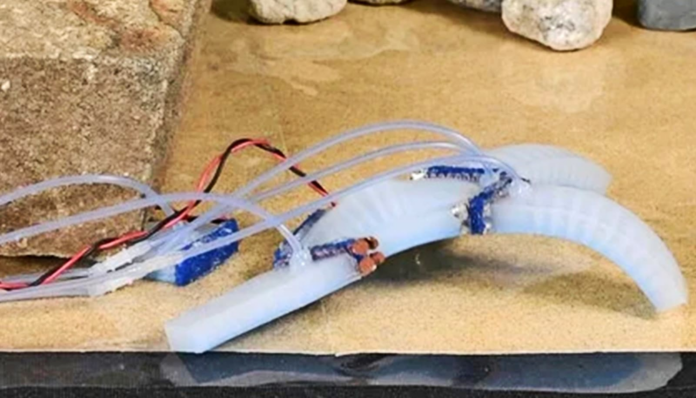Share this
Article Facebook
Twitter
Reddit
Email You are free to share this article under the Attribution 4.0 International license. University Yale University
A new robot can sever its own limbs to escape tricky situations.
Self-amputation may seem like a drastic move, but it’s a survival tactic that’s proved particularly handy for numerous creatures.
Roboticists have drawn inspiration from lizards, crabs, and other animals who shed parts of themselves without looking back, all for the purpose of moving forward.
Outside the lab, a robot could face many potential perils: A falling tree limb, perhaps, or getting stuck under a rock on a search-and-rescue mission. In most cases, that would be it for the robot.
But the Yale University lab of Rebecca Kramer-Bottiglio has developed a technology that allows a robot to selectively disconnect its limbs and free itself from such potential pitfalls.
Conversely, it allows separate robots to join together to take on tasks that they couldn’t do on their own.
Critical to the technology is a material that the roboticists invented in the lab that they call a bicontinuous thermoplastic elastomer. The thermoplastic they use is a rubbery solid at room temperature that melts into a liquid at about 284 °F. It’s infused in a foam-like structure made from silicone that holds the thermoplastic in place when it’s melted into a liquid.
How it works: Two silicone bodies each have a layer of bicontinuous thermoplastic elastomer on their exposed surfaces. The foams are heated so that the thermoplastic melts into liquid. The silicone matrix holds the molten material like a sponge, preventing it from flowing out. Upon contact of the two parts, the molten material combines into a continuous liquid mass. The material then cools and solidifies to connect the two parts. And to disconnect, the joint is heated so that the material melts and weakens, allowing the two parts to separate easily.
“So if the robot is doing its normal operations and walking around the wild, but then something happens to one of its legs—a big rock falls on it, for example—normally the whole robot would be stuck if it were cast in whole,” says Bilige Yang, a PhD student and the lead author of the work.
“But because we have the ability to melt away and weaken this joint where the material is, the rest of the robot will be able to walk away without its amputated leg.”
It’s a similar tactic used by lizards; if an attacker grabs its tail, the lizard automatically releases the limb and scurries to safety. And a crab will shed an injured appendage that’s slowing it down. But the Kramer-Bottiglio lab also points to the world of ants as a source of inspiration. For instance, many ants can link up to form a bridge to cross a gap on the forest floor or form into the shape of a ball to float on water.
Yang points to two small robotic devices on a counter in the lab, and a gap too wide for either of them to safely cross alone.
“If each individual robot tried to cross the gap, it would just fall through,” he says. “But if you have a few of them together, they can make it across. You can imagine this in different types of search-and-rescue missions where the robot will be able to navigate these types of scenarios much better.”
Up next, the research team will apply this technology to many other soft robots they’ve developed in the laboratory.
“Our material not only aids in robot survival—it enables dynamic shape-change,” Kramer-Bottiglio says. “Robotic modules can self-reconfigure into different morphologies to perform tasks that demand specific shapes and behaviors.”
A paper on the robot appears in Advanced Materials.
Source: Yale




